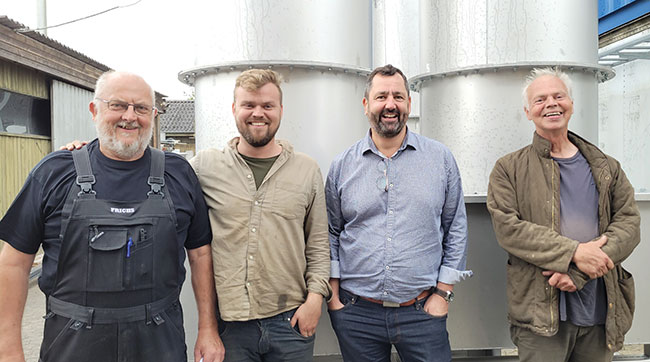
Manure Management: The carbon market
By Jane Robinson
Features New TechnologyA Danish group has designed a greener way to process poultry manure, capturing carbon to create a cleaner agricultural fertilizer – with possibilities beyond the farmyard.
 Partners in Frichs Pyrolysis include (left to right): founder Ovo Munck; Peter Bojsen; CEO Soren Bruun; and Lars Bojsen.
PHOTO: JANE ROBINSON
Partners in Frichs Pyrolysis include (left to right): founder Ovo Munck; Peter Bojsen; CEO Soren Bruun; and Lars Bojsen.
PHOTO: JANE ROBINSON The evolving carbon market is driving innovation for how to effectively capture the building block of greenhouse gas as the world moves closer to net zero emissions. A Danish group has designed a greener way to process poultry manure, capturing carbon to create a cleaner agricultural fertilizer – with possibilities beyond the farmyard.
Lars Bojsen and his son Peter operate Springkilde, a large family farm near Horsens, Denmark. Their operation includes 150,000 laying hens and about 150 hectares of cropland.
Always looking for new options to process the manure generated on the farm, they connected with a local manufacturing firm that was starting to design and build a flash pyrolysis system to process waste material into biochar. They were so intrigued about the possibilities that they became one of the first customers and then joint owners in a new venture called Frichs Pyrolysis.
“There are a lot of systems doing carbon capture, but they generally require a lot of energy,” says Soren Bruun, CEO of Frichs Pyrolysis. “What we’ve created is a process that produces energy, while doing carbon capture. It’s like a Swiss-army knife – a multi-purpose system that delivers a way to capture and store carbon, produce an energy surplus, and recirculate minerals (phosphorus).”
The company is in the process of building a new flash pyrolysis unit on the Bojsen’s farm that will have the capacity to process up to 15 tonnes of dry matter per day. They’ll process the farm’s manure, provide a site where they can collaborate with researchers at the University of Southern Denmark to gather experience and productivity data on the system, and provide a showpiece for promoting the flash pyrolysis system. The project is supported by the European Union’s NextGenerationEU program.
“We need to know the carbon credits created with the system,” says Peter Bojsen. “We are thinking on a global carbon scale and whatever we can do to capture carbon, we need to do it – and pyrolysis is one way to accomplish that.”
The flash pyrolysis process
Pyrolysis uses high heat to convert biomaterial into carbon-rich biochar. Here’s how the process will work for the system at Springkilde. Manure (or any biomass) must be prepped to go into the pyrolysis reactor. This involves drying it down to 80 to 90 per cent dry matter – poultry manure is about 25 per cent dry matter. The dried down manure is then put through a hammermill to create a consistent maximum three-millimetre particle size needed for the pyrolysis process.
The flash pyrolysis reactor heats the manure to 800°C for two to three seconds without oxygen to create biochar and industrial gas from poultry manure. The amounts will vary depending on the biomass material.
The resulting biochar from poultry manure creates a concentrated fertilizer that contains up to 90 per cent pure stable carbon. “This carbon can’t be broken down by bacteria to produce CO2, and when it’s applied to the soil it remains stable for a very long time,” says Bojsen.
The other important component in the biochar is phosphorus. “Through the pyrolysis process, phosphorus from the biomass/manure remains in the biochar and is more stable, more bioavailable and more moveable from areas with a lot of animal production to areas with less,” Bruun says.
Gas produced through the pyrolysis process runs through scrubbers before being used, stored, or sold. About 10 to 15 per cent is needed to power the system, leaving excess available for farm generators or to be upgraded and sold through natural gas networks. Nitrogen – the other component in the original poultry manure – is removed from the biochar and contained in the resulting gas component.
“The work with the University of Southern Denmark will help us evaluate the inputs and outputs and refine the whole process,” Bojsen says. “The university is particularly interested in the gas produced through the process because we already have the complete gas infrastructure in place.”
Manure and more
The new flash pyrolysis system at Springkilde is expected to be running in the early part of 2024. They’ll be using two different sources of biomass – poultry manure and straw – to work with the new system. With a much higher dry matter content, straw doesn’t need to be dried down as much as manure, but also provides fewer nutrients in the resulting biochar.
Agriculture is a natural starting point for the flash pyrolysis system. “Dairy also represents a big benefit for the system from a CO2 emission perspective,” Bojsen says. “The system also makes sense in areas with a land imbalance compared to the manure produced, like the Netherlands.”
After agriculture, Frichs Pyrolysis will set its sights on other industries needing new innovations to handle biomass. “Municipal waste is another opportunity, but we need proof of concept in agriculture before moving into the next market,” says Bruun.
Print this page